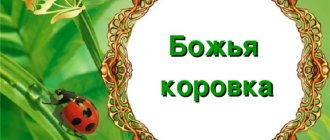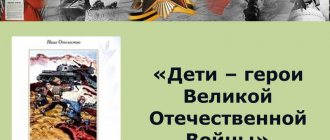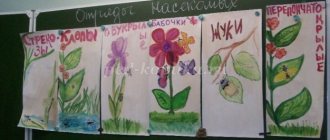Presentation “Structure of the human body” presentation for a lesson on healthy lifestyle (grade 1)
Slide 1
The structure of the human body.
Slide 2
Structure of the human body Look at the diagram and try to explain it. External Internal
Slide 3
External structure is the structure of the human body from the outside.
Slide 4
The external structure of a person includes the following parts of the body: Head Torso Neck Upper limbs Lower limbs Chest Belly Back
Slide 5
Structure of the human body External Internal Head Neck Torso (chest, abdomen, back) Arms Legs Parts of the body
Slide 6
Internal structure. The human body inside consists of organs.
Slide 7
Work according to the textbook. Using the picture on page 7 of the textbook, get acquainted with the internal organs of a person. Pay attention to their location.
Slide 8
Check yourself. Brain Lungs Heart Liver Stomach Intestines
Slide 9
Structure of the human body External Internal Head Neck Torso (chest, abdomen, back) Arms Legs Parts of the body Organs Brain Lungs Heart Liver Stomach Intestines
Slide 10
Brain. The brain is the main command center of the body. All your thoughts, feelings, movements are controlled by the brain.
Slide 11
Lungs. Human breathing occurs with the help of the lungs, which are located in the chest. The lungs are like a sponge. When you exhale, they release air and decrease in size. When we inhale, the lungs fill with air and expand.
Slide 12
Heart. The heart is located in the human chest. It is only the size of a fist. The heart is a tireless motor that continuously drives blood into the vessels and makes it circulate throughout the body.
Slide 13
The stomach is the main compartment of the “inner kitchen”. The stomach is located in the upper abdomen (under the ribs) on the left side. When food gets into it, it stretches. The more food we eat, the more the stomach stretches. In the stomach, food is processed, but only half.
Slide 14
Intestines. From the stomach, food goes on a long journey through the winding intestines. It stretches for almost 8 meters. Only after food has passed this path will it turn into transparent solutions that can be absorbed by the blood and distributed throughout the body.
Slide 15
Liver. The liver lives on the right side of the stomach in the upper abdomen. It produces bile, which enters the intestines and helps digest food.
Slide 16
6) Which organ of the “inner kitchen” looks like a winding labyrinth? 5) This organ is called the “main command post of the whole organism.” 4) What internal organ drives blood into the vessels and causes it to circulate throughout the body 2) What is the name of the neighbor of the stomach located on the right side of it? 3) Which organ is used to breathe? 1) What is the name of the main compartment of the “inner kitchen”?
Slide 17
Body parts. chest 1 2 3 4 5 6 head limb and back neck 7 spine
Slide 18
Internal organs. Answer Stomach Liver 1 2 3 4 5 6 Heart Heart
Presentation “Human Structure”
Elvina Gasanova
Presentation “Human Structure”
Presentation “External structure of a person ”
Tasks:
a person’s appearance , parts of the body, face.
To consolidate knowledge about the senses and their roles.
To form an idea of the internal structure of a person (bones, skin, brain, heart, lungs, stomach, intestines, liver, muscles)
.
Form the idea: a healthy mind in a healthy body.
Text for presentation No. 1
Slide 1: “ Structure of the human body ”
Slide 2: Kostya Kostochkin will tell you about the human structure .
Slide 3: External structure is the structure of the human body from the outside .
Slide 4: This is the head.
Slide 5: This is the neck.
Slide 6: This is the chest.
Slide 7: This is the stomach.
Slide 8: This is the back.
Slide 9: These are two hands. Each hand has five fingers.
Slide 10: These are two legs. Each foot also has five toes.
Slide 11: Test yourself! Main parts of the body: head, neck, chest, back, stomach, leg, arm. The chest, back and abdomen are called by the common word - torso.
Slide 12: Superskeleton
Slide 13: There are bones inside your body. This is you from the inside.
The bones are connected to form a skeleton.
Slide 14: When you cross your legs, your bones look
like this.
Slide 15: When you lie down, the bones look like this.
Slide 16: The bones inside you are connected so deftly that you can easily... scratch the top of your head,
Slide 17: ... sit with your legs and arms crossed,
Slide 18: ...open your mouth to chew.
Slide 19: There are many small bones inside the palm.
Slide 20: Sense organs: ear (hearing, eyes (vision, tongue (taste), nose (smell - smell, skin (touch)
.
Slide 21: Ears help you hear everything that happens
around. This is called hearing.
Slide 22: With your eyes you see everything around you. This is called vision. Look in the mirror. What color are your eyes? Gray? Brown? Blue? Or a pair of beautiful green eyes?
Slide 23: Your tongue is a muscle that can taste food. There are small bumps on the tongue called taste buds. Taste buds determine whether food is good for you.
Slide 24: The nose tells us what it smells like. This is called the sense of smell. The little hairs in your nose help you smell.
Slide 25: When you have a cold, your nose is stuffy and you can’t smell.
Slide 26: With your skin you feel the objects you touch.
This is the sense of touch. The rabbit's fur is soft and smooth.
Slide 27: Homework: Tell your parents about the external structure of the human body .
Text for presentation No. 2 “Internal structure of the human body ”
Slide 1: “ Structure of the human body ”
Slide 2: Kostya Kostochkin will continue to talk about the structure of man . Today we will talk about the internal structure of a person .
Slide 3: The human inside consists of organs.
Slide 4: Brain. The brain is the main command center of the body. All your thoughts, feelings, movements are controlled by the brain.
Slide 5: It works even during sleep. The brain is located inside the head. You can't see him.
Slide 6: Your brain can think. He helps you build models ,
Slide 7: ...putting together puzzles,
Slide 8: ... read.
Slide 9: You need your brain even for the simplest actions: eating...
Slide 10: ...laugh.
Slide 11: Listen to the heart beat. Knock-knock, knock-knock...
Slide 12: The heart is in the human . It is only the size of a fist. The heart is a tireless motor, constantly compressing and unclenching. It continuously drives blood into the vessels and causes it to circulate throughout the body.
Slide 13: The blood inside you runs through special tubes - arteries and veins.
Slide 14: Human occurs with the help of the lungs, which are located in the chest. The lungs are like a sponge.
Slide 15: This is what your lungs look like. Can you feel how you breathe? When you inhale, air enters your lungs - it is necessary for life.
Slide 16: Your lungs expand like this bag when you inhale and deflate when you exhale.
Slide 17: The stomach is the main compartment of the “inner kitchen”
.
The stomach is located in the upper abdomen (under the ribs)
on the left side. When food gets into it, it stretches. The more food we eat, the more the stomach stretches. In the stomach, food is moistened with gastric juice, crushed, ground into pulp, that is, it is digested, but only half.
Slide 18: From the stomach, food goes on a long journey through the intestines, which is like a winding labyrinth, stretching for almost 8 meters. In it, food is finally digested and absorbed by the body.
Slide 19: The stomach has a wonderful neighbor - the liver. It lives on the right side of the stomach in the upper abdomen. It produces bile, which enters the intestines and helps digest food.
Slide 20: Test yourself!
Slide 21: There are muscles under the skin. With their help, your body can do amazing things. Strong muscles help you lift weights.
Slide 22: Flexible, stretchable muscles allow you to move: run,
Slide 23: ...twist the hoop,
Slide 24: ... do gymnastics.
Slide 25: Using your facial muscles, you can make a pouty face or a fish face.
Slide 26: Why do we need to know the structure of the human body ?
To be healthy, you need to go to bed on time,
Slide 27: ...eat healthy food,
Slide 28: ...and of course play sports. Be healthy!
Slide 29: Why do we need food? For your body to work, it needs to be watered and fed healthy food. I eat a lot of healthy food!
Slide 30: Your body needs more fruits and vegetables.
Slide 31: Potatoes, bread, pasta, rice fuel you with energy.
Slide 31: Homework: Tell your parents about the internal structure of the human body .





